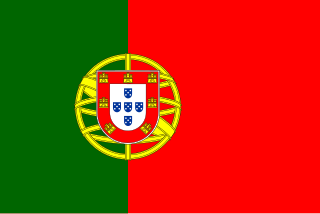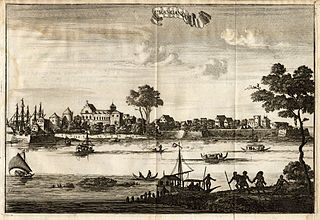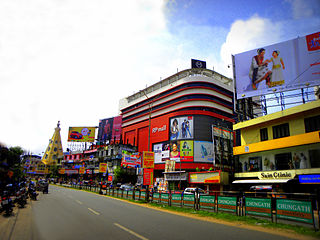Related Research Articles

The State of India, also referred as the Portuguese State of India or simply Portuguese India, was a state of the Portuguese Empire founded six years after the discovery of a sea route to the Indian subcontinent by Vasco da Gama, a subject of the Kingdom of Portugal. The capital of Portuguese India served as the governing centre of a string of military forts and trading posts scattered all over the Indian Ocean.

Kodungallur is a historically significant town situated on the banks of river Periyar on the Malabar Coast in Thrissur district of Kerala, India. It is 29 kilometres (18 mi) north of Kochi (Cochin) by National Highway 66 and 38 km (24 mi) from Thrissur. Kodungallur, being a port city at the northern end of the Kerala lagoons, was a strategic entry point for the naval fleets to the extensive Kerala backwaters. It was here that one of Jesus's disciples, St. Thomas reached during 1st century AD to preach Christianity.

Kollam, also known by its former name Quilon, is an ancient seaport and city on the Malabar Coast of India bordering the Laccadive Sea, which is a part of the Arabian Sea. It is 71 km (44 mi) north of the state capital Thiruvananthapuram. The city is on the banks of Ashtamudi Lake and the Kallada river. Kollam is the fourth largest city in Kerala and is known for cashew processing and coir manufacturing. It is the southern gateway to the Backwaters of Kerala and is a prominent tourist destination. Kollam is one of the most historic cities with continuous settlements in India. Geographically, Quilon formation seen around coastal cliffs of Ashtamudi Lake, represent sediments laid down in the Kerala basin that existed during Mio-Pliocene times.

Anizham Thirunal Marthanda Varma was the founding monarch of the southern Indian Kingdom of Travancore from 1729 until his death in 1758. He was succeeded by Rama Varma (1758–98).
Venad was a medieval Hindu kingdom lying between the Western Ghat mountains and the Arabian Sea on the south-western tip of India with its headquarters at the port city of Kollam/Quilon. It was one of the major principalities of Kerala, along with kingdoms of Kannur (Kolathunadu), Kozhikode (Nediyiruppu), and Kochi (Perumpadappu) in medieval and early modern period.
The term Kerala was first epigraphically recorded as' ([|Keralaputra]]) in a 3rd-century BCE rock inscription by the Mauryan emperor Ashoka of Magadha. It was mentioned as one of four independent kingdoms in southern India during Ashoka's time, the others being the Cholas, Pandyas and Satyaputras. The Cheras transformed Kerala into an international trade centre by establishing trade relations across the Arabian Sea with all major Mediterranean and Red Sea ports as well those of Eastern Africa and the Far East. The dominion of Cheras was located in one of the key routes of the ancient Indian Ocean trade. The early Cheras collapsed after repeated attacks from the neighboring Cholas and Rashtrakutas.

Mount Carmel Convent Anglo-Indian Girls High School is an English-medium all-through school in Tangasseri, Kollam District in Kerala, India. Located on the shores of the Arabian Sea, it consists of a day school, and a boarding house located within the convent. The school was founded on 22 July 1885 by Mother Veronica of the Passion. It was one of the first English-medium schools in the Kollam District, and is one of its two originally Anglo-Indian schools. The school awards qualifications based on the ICSE/ISC syllabus.

Tangasseri or Thangassery (Thangi) is a heavily populated beach area on the shores of the Arabian Sea in Kollam city, Kerala, India.

Kollam Beach, also known as Mahatma Gandhi Beach, is a beach at Kollam city in the Indian state of Kerala. Kollam Beach is the first 'Beach Wedding Destination' in Kerala.

Fort Thomas or St. Thomas Fort or Fortaleza da São Tomé, also known as Tangasseri Fort, is a ruined fort located in the beach town of Tangasseri on the shores of the Arabian Sea in the city of Kollam, Kerala, India. It is located around 5 kilometres (3.1 mi) from the city center of Kollam and 71 kilometres (44 mi) from the state capital Thiruvananthapuram.

Tangasseri Lighthouse or Thangassery Lighthouse is situated at Tangasseri in Kollam city of the Indian state of Kerala. It is one of the two lighthouses in the Kollam Metropolitan Area and is maintained by the Cochin Directorate General of Lighthouses and Lightships. In operation since 1902, the cylindrical lighthouse tower painted with white and red oblique bands has a height of 41 metres (135 ft), making it the second tallest lighthouse in Kerala coast. Tangasseri Lighthouse is one of the most visited lighthouses in Kerala.

Kollam or Quilon is an old seaport and a city on the Laccadive Sea coast in Kerala, India, on Ashtamudi Lake. The city remains notable as the ancient commercial capital of Kerala and the southwestern Indian coast, in addition to its fame as the "Cashew Capital of the World". The Kollam Municipal Corporation has the second largest budget in Kerala in terms of revenue and expenditure.

The Infant Jesus Cathedral is a historic Roman Catholic church established by Portuguese during 1614, situated at Tangasseri in the city of Quilon (Kollam), India. It is now the cathedral i.e the Seat of the Bishop of Roman Catholic Diocese of Quilon, the ancient and first catholic diocese of India. The Church remains as a memento of the Portuguese rule of old Quilon city.

Transport in Kollam includes various modes of road, rail and water transportation in the city and its suburbs. State-owned Kerala State Road Transport Corporation buses, private buses, Indian Railways, state-owned Kerala State Water Transport Department boats & ferry, taxis and auto rickshaws are serving the city of Kollam. The city had a strong commercial reputation since the days of the Phoenicians and Romans. Ibn Battuta mentioned Kollam Port as one of the five Indian ports he had seen during the course of his twenty-four year travels.

Kollam KSWTD Boat Jetty or Kollam KSWTD Ferry Station is an transport hub in the city of Kollam in Kerala, India, one of 14 ferry stations owned by the Kerala State Water Transport Department.
The Portuguese Cemetery of Tangasseri in Kollam city, India, was constructed around 1519 as part of the Portuguese invasion of the city. Buckingham Canal, a small canal between Tangasseri Lighthouse and the cemetery, is situated very close to the Portuguese Cemetery. A group of pirates known as the Pirates of Tangasseri formerly lived at the Cemetery. The remnants of St. Thomas Fort and Portuguese Cemetery still exist at Tangasseri.

Kollam Canal or Quilon Canal or Kollam Thodu is a 7.7 km long canal system passing through the city of Kollam, India. It is a part of National Waterway-3 and 78 km long Kollam-Trivandrum (Kovalam) State waterway project.

Kollam–Thiruvananthapuram trunk line is a railway line in Southern Railway zone connecting the cities of Kollam and Thiruvananthapuram in the state of Kerala, India. The line was opened on 4 January 1918 as the extension of Madras–Quilon line during metre gauge era.

Quilon or Coulão, officially Kollam is one of the ancient civilizations in India.It is one of the oldest port cities in the Malabar Coast and was the capital city of historic Venad Kingdom and Travancore Kingdom. Quilon was once an important trading port in India. It was also known as Desinganadu. It is now known as the "Cashew Capital of the World".

City of Kollam or Quilon is a Port city in South India and was the commercial capital of erstwhile Kingdom of Travancore. It is situated on the Laccadive Sea coast of South Kerala. The city is known as the "Gateway to the backwaters of Kerala". The city lies on the banks of Ashtamudi Lake, Kerala's second largest lake, on the Arabian sea coast. Major parts of Kollam city are covered by Ashtamudi Lake.
References
- ↑ "Buckingham Canal being reclaimed". The Hindu. Retrieved 20 March 2015.
- ↑ "Death knell for Buckingham canal at Thangasseri". iBN Live. Archived from the original on 12 April 2015. Retrieved 20 March 2015.
- ↑ "Buckingham Canal's rich past becoming history". The New Indian Express. Archived from the original on 2 April 2015. Retrieved 20 March 2015.
- ↑ "Tangasseri - OOCITIES". OOCITIES. Retrieved 9 January 2014.
- ↑ "Archaeological site and remains". Archaeological Survey of India - Thrissur Circle. Retrieved 9 January 2014.
- ↑ "Death knell for Buckingham canal at Thangasseri". The New Indian Express. Archived from the original on 2 April 2015. Retrieved 20 March 2015.